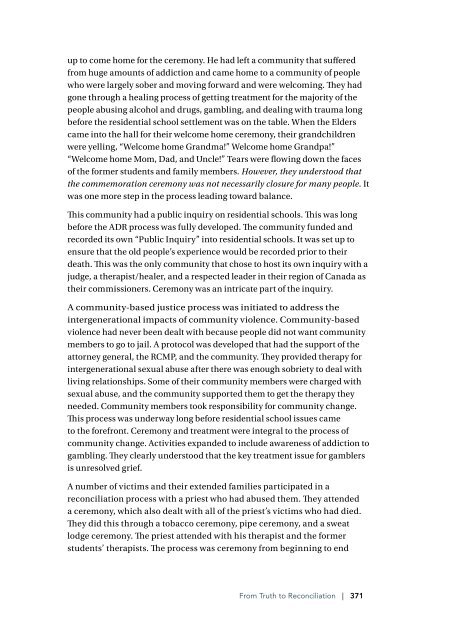Maggie Hodgson - Speaking My Truth
Maggie Hodgson - Speaking My Truth
Maggie Hodgson - Speaking My Truth
Create successful ePaper yourself
Turn your PDF publications into a flip-book with our unique Google optimized e-Paper software.
up to come home for the ceremony. He had left a community that suffered<br />
from huge amounts of addiction and came home to a community of people<br />
who were largely sober and moving forward and were welcoming. They had<br />
gone through a healing process of getting treatment for the majority of the<br />
people abusing alcohol and drugs, gambling, and dealing with trauma long<br />
before the residential school settlement was on the table. When the Elders<br />
came into the hall for their welcome home ceremony, their grandchildren<br />
were yelling, “Welcome home Grandma!” Welcome home Grandpa!”<br />
“Welcome home Mom, Dad, and Uncle!” Tears were flowing down the faces<br />
of the former students and family members. However, they understood that<br />
the commemoration ceremony was not necessarily closure for many people. It<br />
was one more step in the process leading toward balance.<br />
This community had a public inquiry on residential schools. This was long<br />
before the ADR process was fully developed. The community funded and<br />
recorded its own “Public Inquiry” into residential schools. It was set up to<br />
ensure that the old people’s experience would be recorded prior to their<br />
death. This was the only community that chose to host its own inquiry with a<br />
judge, a therapist/healer, and a respected leader in their region of Canada as<br />
their commissioners. Ceremony was an intricate part of the inquiry.<br />
A community-based justice process was initiated to address the<br />
intergenerational impacts of community violence. Community-based<br />
violence had never been dealt with because people did not want community<br />
members to go to jail. A protocol was developed that had the support of the<br />
attorney general, the RCMP, and the community. They provided therapy for<br />
intergenerational sexual abuse after there was enough sobriety to deal with<br />
living relationships. Some of their community members were charged with<br />
sexual abuse, and the community supported them to get the therapy they<br />
needed. Community members took responsibility for community change.<br />
This process was underway long before residential school issues came<br />
to the forefront. Ceremony and treatment were integral to the process of<br />
community change. Activities expanded to include awareness of addiction to<br />
gambling. They clearly understood that the key treatment issue for gamblers<br />
is unresolved grief.<br />
A number of victims and their extended families participated in a<br />
reconciliation process with a priest who had abused them. They attended<br />
a ceremony, which also dealt with all of the priest’s victims who had died.<br />
They did this through a tobacco ceremony, pipe ceremony, and a sweat<br />
lodge ceremony. The priest attended with his therapist and the former<br />
students’ therapists. The process was ceremony from beginning to end<br />
From <strong>Truth</strong> to Reconciliation | 371

















